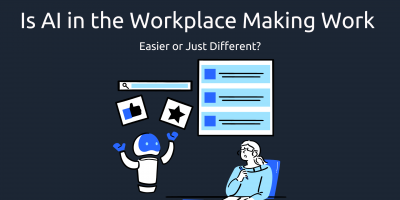
Accounts Payable Outsourcing vs. In-House Processing
Accounts payable remains heavily manual, consuming time and resources. Could automation or outsourcing to AP specialists be the better way forward?


CEO & Founder of Home Grounds

Founder of Lower Street

Human Resource Manager of Tomedes

CEO & President at Redfish Technology

Sr. Corporate Investigator at Corporate Investigation Consulting

Founder of milepro

Co-Founder & CEO of OSHA Outreach Courses

Founder & CEO of Compt

Co-founder & CMO of NCHC
The traditional recruitment model is slowly becoming outdated in a candidate-driven job market.
Posting job ads, waiting for applications, and making the right hire can be costly and time-consuming, which presents an opportunity for a different approach – employee referrals.
An employee referral can be a powerful tool for companies who want to hire faster and more efficiently.
Yet, its benefits are often overlooked.
Research shows that referred employees outperform other workers, are more satisfied, and have higher retention rates. Besides, almost two-thirds have referred at least one employee, continuing the cycle of quality hires.
Still, while most use it to some extent, only 46% of smaller companies and 69% of large employers have a documented referral program.
Exploring the power of employee referrals in today’s job market, this Shortlister article examines how companies can tap into this potential and use it to their advantage.
An employee referral is a recruitment strategy in which current employees are encouraged to recommend candidates for open positions within their organization.
As a word-of-mouth process, it goes beyond job boards, ads, or talent pools. Instead, this approach leverages personal or professional connections of the company’s workforce, leading to the discovery of candidates who may not have applied through traditional job postings.
Many companies incentivize employee referrals and offer bonuses or other rewards to increase the likelihood of landing quality candidates.
Referral programs have always been a robust growth tactic that predates modern marketing and, in the workplace, modern recruitment.
Yet, over the years, the concept has remained the same – using the power of word-of-mouth recommendations to boost growth efficiently and cost-effectively.
Today’s structured and formal employee referral programs encourage workers to recommend someone they think would be a good fit for the open role. Usually, this is a family member, a friend, or a former colleague.
“The power of employee referral lies in the power of employees’ networks,” explains Alex Mastin, CEO and Founder of Home Grounds.
“This is an internal way of hiring that relies on the connections that employees have to others who may be suited for a role in their company.”
Once the employee identifies a referral, they submit it to the HR department, a manager, or a team leader. Then, the hiring team evaluates the candidate alongside other applicants.
If the candidate is hired, the referring employee is eligible for incentives, such as cash bonuses.
Some employers switch out monetary rewards with incentives like extra vacation days or vouchers, which could also increase interest, depending on employee preferences.
According to Harry Morton, Founder of Lower Street, referrals help leaders maintain a continuous talent pipeline.
“Having this steady stream of skilled professionals at your fingertips is a game-changer.
It ensures we’re always ready to tackle new projects, adapt to client demands, and scale our operations without the challenge of prolonged hiring processes,” explains Morton.
The effectiveness of employee referral programs further depends on how well-defined they are. Findings from Aptitude Research reveal that although 82% of employers use them in some way, most programs fail due to a lack of awareness or when employees don’t have an easy way to share these opportunities with their network.
Therefore, beyond incentives, it’s vital to provide clear guidelines and make the process transparent so that each candidate gets a fair evaluation to avoid potential biases in the hiring process.

The significance of employee referrals goes beyond their simple and timeless mechanism. In today’s employee-centric workplace, they have become a company’s secret recruiting weapon.
In fact, for 84% of employers, referrals are the most cost-effective way to source talent.
Speaking of their effectiveness in a Forbes article, author and entrepreneur Jeff Hyman refers to these programs as the “Holy Grail of hiring”. Backed up by data, he points out their benefits, including:
However, Hyman argues they are often under-marketed, inconvenient, or poorly run.
While referral programs effectively source quality candidates, employers may struggle to optimize them to deliver consistent results, seething forth both advantages and disadvantages to this process.
With numerous studies over the years to prove it, we’ve seen that referrals hold many benefits. They’re cost-effective, drive better retention, and work well in sourcing quality candidates.
To gain better insight, let’s take a more in-depth look at all the advantages of employee referrals.
Referrals can save businesses $3,000 per hire or more.
While traditional recruitment costs between $4,200 and $18,000, an employee referral usually costs companies $1,000 per hire.
They remove expenditures with advertising, external recruitment, and unqualified candidates. Along with data showing 82% of employers rating these programs as having the best ROI, cost-effectiveness is undoubtedly a significant advantage of employee referrals.

An employee referral increases the odds of landing a better candidate.
Current workers usually have an insight into the company’s requirements, expectations, and workflows, which allows them to make a quality candidate recommendation that matches the criteria and is a better cultural fit. Also, referrals are a great way to fill specialized roles that require a specific skill set or are within a niche industry.
Rob Reeves, the CEO and President of Redfish Technology, explains: “As a recruiter, I have access to a vast pool of candidates. And yet, when it comes to my own company, I find myself leaning on close referrals.
The reason is simple: Without collaboration, the most skilled workforce will struggle.
In fact, I’d go as far as to say that successful teamwork can be as crucial as experience or education.”
A better hire would drive higher retention, and according to LinkedIn’s Global Talent Trends 2020 report, employee retention with internal hiring is 41% longer. Moreover, data also shows higher retention in referred workers specifically.
Sr. Corporate Investigator at Corporate Investigation Consulting, Timothy Allen, agrees that employee referrals often lead to higher retention rates within an organization.
“I saw this firsthand when my employer recruited someone suggested by a long-term employee. This new hire already had a built-in support structure within the organization and immediately felt a sense of belonging.
This sense of belonging and camaraderie motivated them to remain with the organization in the long run.
Their retention not only saved us the time and resources often spent on staff replacement, but it also contributed to a steady and seasoned team, which benefited the company’s growth and performance,” explains Allen.
Closely connected with hiring a better culture-fit employee, when new hires align well with the existing workplace values, they are more likely to feel comfortable and engaged in their roles, which can lead to longer tenures.

Finally, along with doubling first-year retention and the likelihood of a quality hire, research by Aptitude shows that 62% of companies reduce their time to fill a position through employee referrals.
Speaking from experience, Tim White, founder of Milepro, agrees that speed of recruitment is a valuable benefit of employee referrals.
White explains: “When employees recommend candidates from their professional networks, it can significantly shorten the hiring process.
In my experience, an employee referral led to the swift onboarding of a talented individual who was already familiar with our industry and ready to contribute immediately.
This not only saved time and resources but also helped us meet critical project deadlines.”
Overall, this added benefit makes it easier for HR teams to meet their hiring goals without wasting too much time and resources.

Over the years, extensive research has supported the advantage of employee referrals, from their efficiency to the quality of candidates. However, in the landscape of benefits, it’s easy to overlook the disadvantages.
For one, the lack of diversity seems to be a big issue.
When workers suggest candidates, it’s usually someone they know or a family member, leaving room for nepotism in the workplace.
Human Resource Manager of Tomedes, Jerica Amores Fernan, explains:
“If a considerable proportion of hires are through referrals, it may promote an impression of favoritism or nepotism inside the workplace, impacting morale and fairness perceptions among other employees.”
Beyond the obvious drawbacks, this can also create homogenous teams that may not reflect a broad range of perspectives and backgrounds, ultimately disadvantaging the company.
Statistics on the importance of diversity and inclusion suggest 35% better performance for ethnically diverse businesses and 15% improved performance when the workforce is gender diverse.
“Referrals from employees with similar demographics or backgrounds may predominate, resulting in a lack of diversity in the workforce. This might narrow the organization’s vision and stifle creativity and innovation,” argues Fernes.
“Furthermore, there is a risk of neglecting more competent prospects outside of the referral network, which could hurt the entire talent pool.”
Another significant disadvantage is the transparency issue, usually due to a poorly organized referral program or lack thereof.
For example, without clear guidelines regarding the program’s structure, rewards, and eligibility criteria, employees may hesitate to refer candidates.
Moreover, this lack of transparency can lead to internal issues.
Workers might question the program’s fairness, suspect favoritism, or feel discouraged if they believe the referral process is biased or unclear.
Along with overly complicated incentive systems, low-quality candidate control, and a more limited pool of applicants, companies should consider all aspects of referral programs.
Ultimately, many organizations balance employee referrals with other recruitment methods and employ technology to streamline the referral process and mitigate these disadvantages.

The rise of technology in the past few decades has forever changed recruitment and hiring.
Tools like Applicant Tracking Systems (ATS) have been beneficial in streamlining the entire employment process, and they also play a significant role in employee referrals. For example, ATS software can efficiently track and evaluate candidates, providing a centralized platform for managing referrals in all hiring and onboarding stages.
In recent years, referral technology platforms have also made a breakthrough in candidate outsourcing by automating this process. In fact, according to the 2023 Employee Referral Software Market Research, the market size is valued at $347.24 million, with estimates to reach $934.03 million in 2028.
This growth is likely due to the speed and accuracy this technology provides in managing employee referrals, all while empowering organizations to tap into a wider talent pool.
However, although recruiters and hiring teams should use ATS, referral software, and other recruitment tools to administer referral programs, they shouldn’t rely solely on them.
Instead, companies must prioritize the development of a carefully curated strategy that encourages employee engagement and active referrals, ensuring that technology complements and enhances the human element in streamlining the referral process.
Getting a referral is easier said than done.
Thus, companies should set up a referral system to achieve sustainable results. This well-structured program transforms word-of-mouth recommendations into a business strategy.
While there isn’t a one-size-fits-all approach to how to set up an employee referral program, these are the essential checklist items companies can follow to streamline the process.

First off, setting up a goal is of vital importance.
As with any other strategy, this step helps keep things in perspective and provides a general direction for the program, including its purpose and expectations. For example, a company can set a goal to increase the percentage of hires per year by 15% and devise strategies to attain this goal.
The goal-setting stage also includes determining KPIs and a timeline to measure them, like the number of referrals, the percentage increase in qualified applicants, or the reduction in recruitment costs.
Moreover, it’s also an opportunity to set up a communication plan, determine the budget, and ensure compliance.
Once the goals are set, it’s time to create the program, starting with the incentive.
As the core of a referral bonus program, incentives motivate workers to participate. So, the better they are, the likelier it is for a company to get a referral.
While cash incentives are usually the go-to rewards, companies should decide on this based on their employees’ preferences.
“Good referrals should be rewarded with bonuses,” says Farhan Siraj, Co-Founder and CEO at OSHA Outreach Courses.
“Since an employee has saved you both time and money that is spent in the alternative hiring process, your organization should be generous enough to reward them for their service,” Siraj adds.
For Amy Spurling, Founder and CEO of Compt, another effective strategy is recognizing and celebrating successful referrals publicly.
“Highlighting the contributions of employees who refer outstanding candidates through internal communications, company meetings, or rewards programs can create a sense of pride and encourage more referrals.”
Beyond this, choosing employee incentives means setting up referral bonus amounts and referral bonus eligibility.
The simpler the program, the better the outcome.
Employees need to understand the process and have a user-friendly referral system where they can submit a candidate, for example, an internal job portal. Digital tools can help automate this process so it’s not confusing or complicated, which brings us to the next step.
ATS, candidate management systems, reference checking, and referral software – implementing these digital tools can centralize the process.
It makes it easier for employees to submit referrals and for recruiters or HR professionals to manage them along with other applicants, automate candidate evaluations, streamline communication with candidates, and collect HR metrics to track the program’s success.
Good collaboration between teams is imperative to the success of employee referral programs.
Managers and all leadership should be well acquainted and involved with the referral system just as much as their employees are. Their involvement helps align the program with strategic goals, secure necessary resources, and ensure the program is well-integrated into the company culture and policies.
Employees appreciate transparency.
Therefore, it’s vital to give feedback on the status of their referrals, including information on candidate rejection or whether their referral is being interviewed and hired.
According to Amy Spurling: “Organizations can make the referral process simple and user-friendly by providing easy-to-use referral platforms or tools.
Clear guidelines and expectations for referrals, as well as regular updates on the status of referred candidates, can also enhance the experience for employees.
Transparent communication goes a long way!”
After a successful hire, employees should receive the incentive.
However, it’s also essential to follow up and continue to engage with workers who referred successful candidates, acknowledging their contribution to the company.
We’ve seen that referrals are an excellent way to attract quality candidates. However, they are not a guarantee.
Referral programs shouldn’t be the only candidate source if we consider potential disadvantages like limited diversity and inclusion within teams or lack of low-quality candidate control.
Instead, use them interchangeably with traditional job advertising and other hiring tactics.
“It’s essential to strike a balance between employee referrals and other recruitment methods to ensure diversity and inclusion.
The worst, and often toxic, organizations are the ones where everyone looks and thinks the same,” explains Amy Spurling.
Suppose the referred candidate passes the initial reference check. In that case, the hiring team should proceed with the same thorough evaluation and interview processes as any other candidate, ensuring a fair and consistent assessment of qualifications, skills, and cultural fit.

Finally, ensuring sustainability requires tracking and evaluating performance results.
This includes assessing the quantity and quality of referrals, understanding which roles are most effectively filled through referrals, and measuring the time-to-fill for these positions.
Analyzing the data and finding potential pain points helps companies identify areas for program improvement and use them to streamline the referral process further.
Although many employers still underutilize this hiring method or do not employ it at all, the power of an employee referral is evident.
However, the extent of the benefits depends on understanding how to secure referrals effectively.
A few ways of doing this is for companies to:
Logan Nguyen, Co-founder and CMO of NCHC, adds: “Creating a referral culture in your company encourages employees to be your brand advocates. This will boost trust between team members and generate genuine referrals.
The best way to create an effective referral culture is to involve the employees in the recruitment process, provide regular feedback, and recognize achievements”.
When workers feel engaged, appreciated, and well-informed, they are more likely to actively participate in the process and provide a high-quality employee referral, leading to a mutually beneficial outcome for both the employees and the employer.
Content Writer at Shortlister
Browse our curated list of vendors to find the best solution for your needs.
Subscribe to our newsletter for the latest trends, expert tips, and workplace insights!

Accounts payable remains heavily manual, consuming time and resources. Could automation or outsourcing to AP specialists be the better way forward?

With the rise of AI in the workplace, its impact has become multi-dimensional. While there is no doubt about its ability to reduce manual labor, this technology also reshapes job expectations, creating new opportunities and challenges.

Running a small business? Explore HR software that makes managing your team easier, faster, and more efficient.

As machines take on more at work, the question isn’t how fast AI can go, but whether we’re ready for where it’s taking us.
Used by most of the top employee benefits consultants in the US, Shortlister is where you can find, research and select HR and benefits vendors for your clients.
Shortlister helps you reach your ideal prospects. Claim your free account to control your message and receive employer, consultant and health plan leads.